Hyundai Santa Fe vs Land Rover Range Rover Velar – Performance, range & efficiency compared
Two cars, one duel: Hyundai Santa Fe meets Land Rover Range Rover Velar.
Which one wins in performance, efficiency and value for money? Find out now!
Costs and Efficiency:
When it comes to price and running costs, the biggest differences usually appear. This is often where you see which car fits your budget better in the long run.
Hyundai Santa Fe has a evident advantage in terms of price – it starts at 51200 £, while the Land Rover Range Rover Velar costs 61900 £. That’s a price difference of around 10671 £.
Fuel consumption also shows a difference: Hyundai Santa Fe manages with 1.70 L and is therefore convincingly more efficient than the Land Rover Range Rover Velar with 4.80 L. The difference is about 3.10 L per 100 km.
As for range, the Land Rover Range Rover Velar performs somewhat better – achieving up to 63 km, about 9 km more than the Hyundai Santa Fe.
Engine and Performance:
Power, torque and acceleration are the classic benchmarks for car enthusiasts – and here, some clear differences start to show.
When it comes to engine power, the Land Rover Range Rover Velar has a noticeable edge – offering 404 HP compared to 253 HP. That’s roughly 151 HP more horsepower.
In acceleration from 0 to 100 km/h, the Land Rover Range Rover Velar is clearly quicker – completing the sprint in 5.40 s, while the Hyundai Santa Fe takes 9 s. That’s about 3.60 s faster.
In terms of top speed, the Land Rover Range Rover Velar performs clearly perceptible better – reaching 250 km/h, while the Hyundai Santa Fe tops out at 196 km/h. The difference is around 54 km/h.
There’s also a difference in torque: Land Rover Range Rover Velar pulls clearly stronger with 650 Nm compared to 380 Nm. That’s about 270 Nm difference.
Space and Everyday Use:
Cabin size, boot volume and payload all play a role in everyday practicality. Here, comfort and flexibility make the difference.
Seats: Hyundai Santa Fe offers distinct more seating capacity – 7 vs 5.
In curb weight, Hyundai Santa Fe is hardly perceptible lighter – 1920 kg compared to 2003 kg. The difference is around 83 kg.
In terms of boot space, the Hyundai Santa Fe offers clearly perceptible more room – 711 L compared to 552 L. That’s a difference of about 159 L.
In maximum load capacity, the Hyundai Santa Fe performs clearly perceptible better – up to 2032 L, which is about 674 L more than the Land Rover Range Rover Velar.
When it comes to payload, Hyundai Santa Fe somewhat takes the win – 665 kg compared to 587 kg. That’s a difference of about 78 kg.
Who comes out on top?
Overall, the Hyundai Santa Fe shows itself to be wins the duel decisively and secures the title of DriveDuel Champion.
It convinces with the more balanced overall package and proves to be the more versatile choice for everyday use.
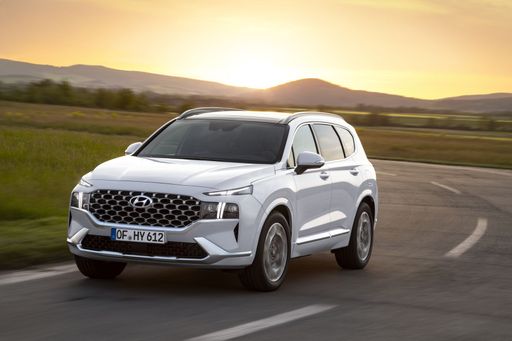
Hyundai Santa Fe
Hyundai Santa Fe
The Hyundai Santa Fe offers a refined blend of style and functionality, making it a strong contender in the SUV market. Its modern interior, combined with advanced technology and comfort features, creates an inviting and practical driving environment. With its sleek design and robust performance, the Santa Fe is well-suited for both urban commutes and family adventures.
details @ hyundai.news
@ hyundai.news
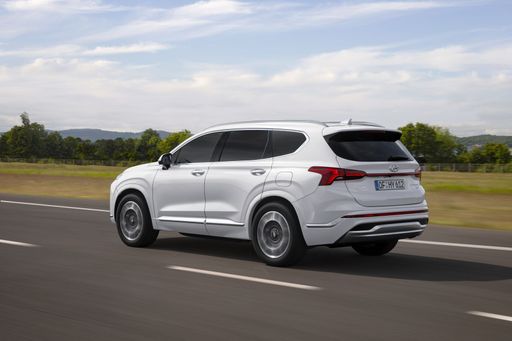 @ hyundai.news
@ hyundai.news
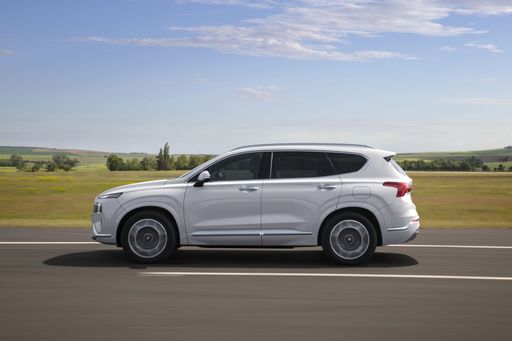 @ hyundai.news
@ hyundai.news
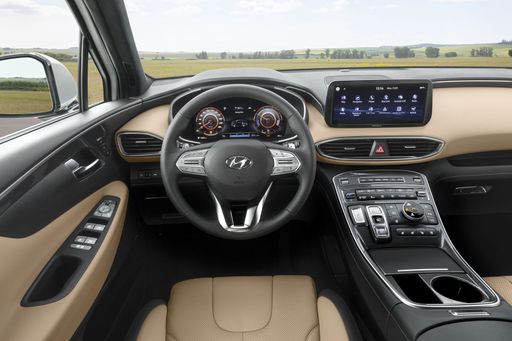 @ hyundai.news
@ hyundai.news
 @ hyundai.news
@ hyundai.news
Land Rover Range Rover Velar
The Land Rover Range Rover Velar exemplifies a harmonious blend of elegance and capability, capturing the essence of modern luxury SUVs. Its sleek silhouette and refined design details make it stand out on both urban roads and off-road adventures. Inside, the Velar offers an impeccably crafted interior, combining premium materials with cutting-edge technology for a sophisticated driving experience.
details @ media.landrover.com
@ media.landrover.com
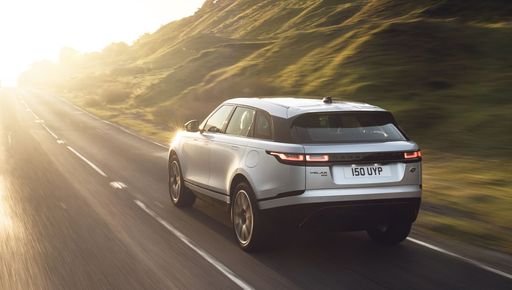 @ media.landrover.com
@ media.landrover.com
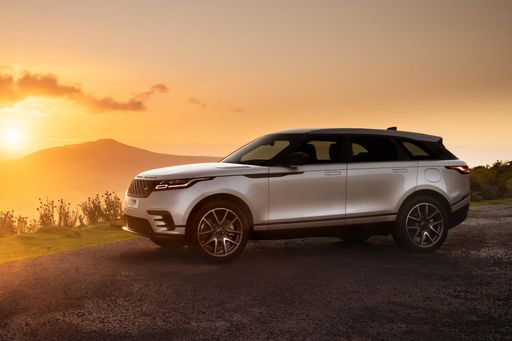 @ media.landrover.com
@ media.landrover.com
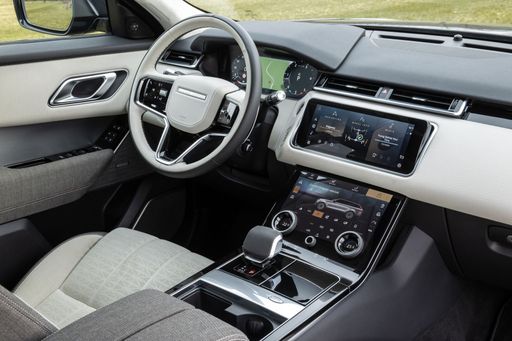 @ media.landrover.com
@ media.landrover.com

|

|
|
|
|
Costs and Consumption |
|
|---|---|
|
Price
51200 - 58400 £
|
Price
61900 - 87400 £
|
|
Consumption L/100km
1.7 - 7.1 L
|
Consumption L/100km
4.8 - 10.2 L
|
|
Consumption kWh/100km
-
|
Consumption kWh/100km
-
|
|
Electric Range
54 km
|
Electric Range
63 km
|
|
Battery Capacity
-
|
Battery Capacity
15.40 kWh
|
|
co2
38 - 160 g/km
|
co2
110 - 232 g/km
|
|
Fuel tank capacity
47 - 67 L
|
Fuel tank capacity
62 - 83 L
|
Dimensions and Body |
|
|---|---|
|
Body Type
SUV
|
Body Type
SUV
|
|
Seats
5 - 7
|
Seats
5
|
|
Doors
5
|
Doors
5
|
|
Curb weight
1920 - 2165 kg
|
Curb weight
2003 - 2280 kg
|
|
Trunk capacity
621 - 711 L
|
Trunk capacity
503 - 552 L
|
|
Length
4830 mm
|
Length
4797 mm
|
|
Width
1900 mm
|
Width
1933 mm
|
|
Height
1720 mm
|
Height
1657 - 1665 mm
|
|
Max trunk capacity
1942 - 2032 L
|
Max trunk capacity
1335 - 1358 L
|
|
Payload
560 - 665 kg
|
Payload
460 - 587 kg
|
Engine and Performance |
|
|---|---|
|
Engine Type
Plugin Hybrid, Full Hybrid
|
Engine Type
Petrol MHEV, Plugin Hybrid, Diesel MHEV
|
|
Transmission
Automatic
|
Transmission
Automatic
|
|
Transmission Detail
Automatic Gearbox
|
Transmission Detail
Automatic Gearbox
|
|
Drive Type
All-Wheel Drive, Front-Wheel Drive
|
Drive Type
All-Wheel Drive
|
|
Power HP
239 - 253 HP
|
Power HP
204 - 404 HP
|
|
Acceleration 0-100km/h
9 - 9.3 s
|
Acceleration 0-100km/h
5.4 - 8.3 s
|
|
Max Speed
180 - 196 km/h
|
Max Speed
209 - 250 km/h
|
|
Torque
367 - 380 Nm
|
Torque
430 - 650 Nm
|
|
Number of Cylinders
4
|
Number of Cylinders
4 - 6
|
|
Power kW
176 - 186 kW
|
Power kW
150 - 297 kW
|
|
Engine capacity
1598 cm3
|
Engine capacity
1997 - 2997 cm3
|
General |
|
|---|---|
|
Model Year
2024 - 2025
|
Model Year
2025
|
|
CO2 Efficiency Class
B, E, F
|
CO2 Efficiency Class
G, C
|
|
Brand
Hyundai
|
Brand
Land Rover
|
What drivetrain options does the Hyundai Santa Fe have?
Available configurations include All-Wheel Drive or Front-Wheel Drive.
The prices and data displayed are estimates based on German list prices and may vary by country. This information is not legally binding.
